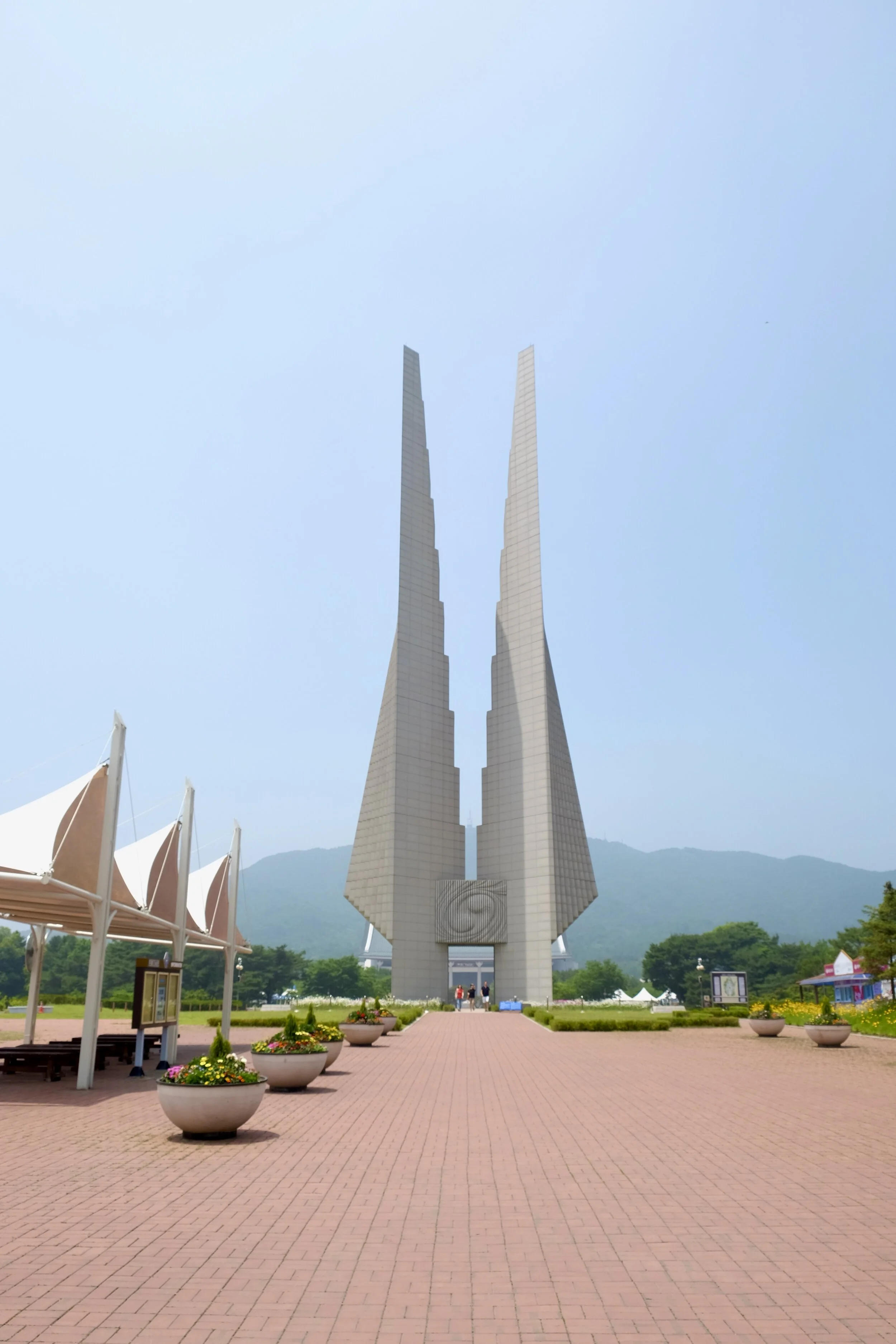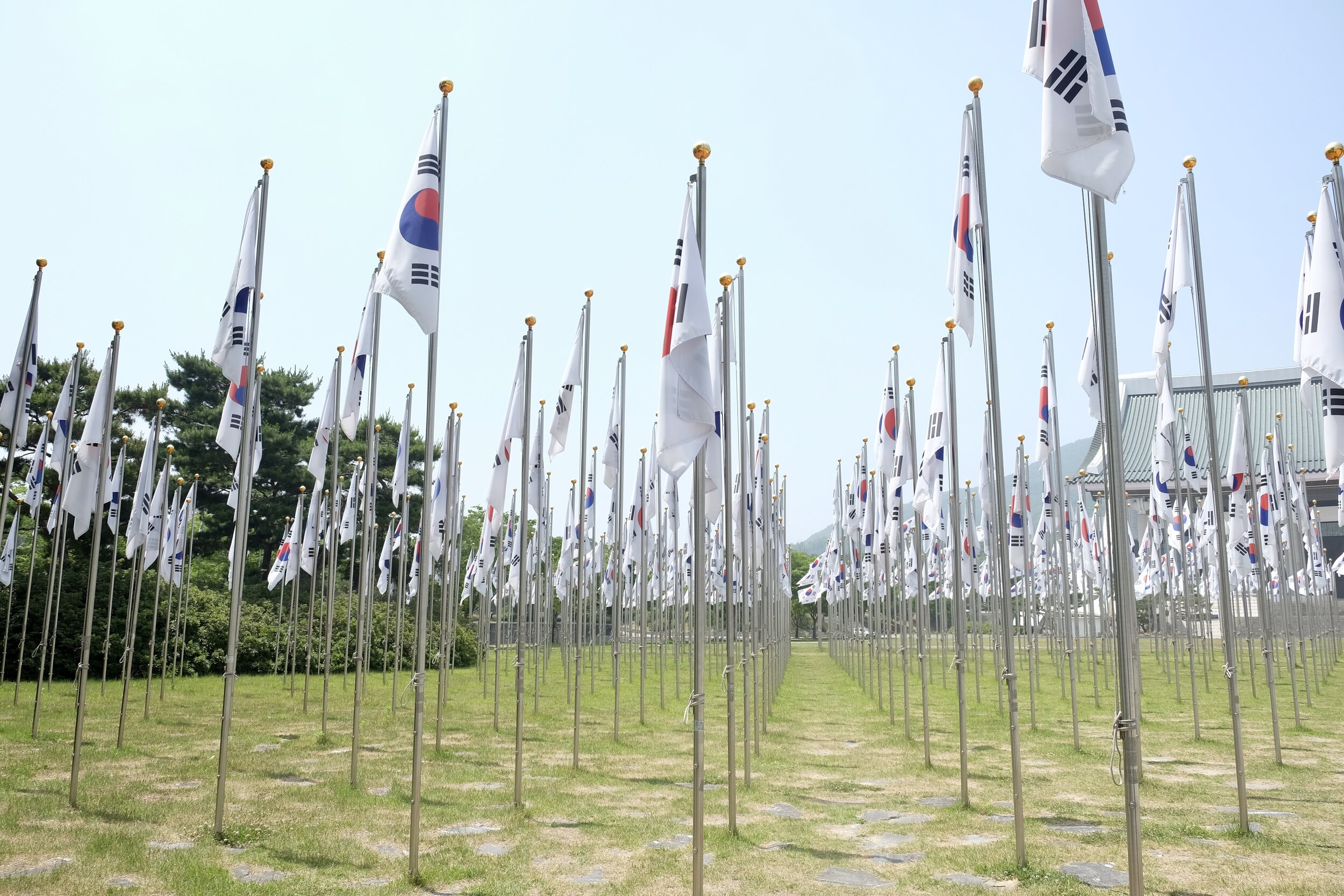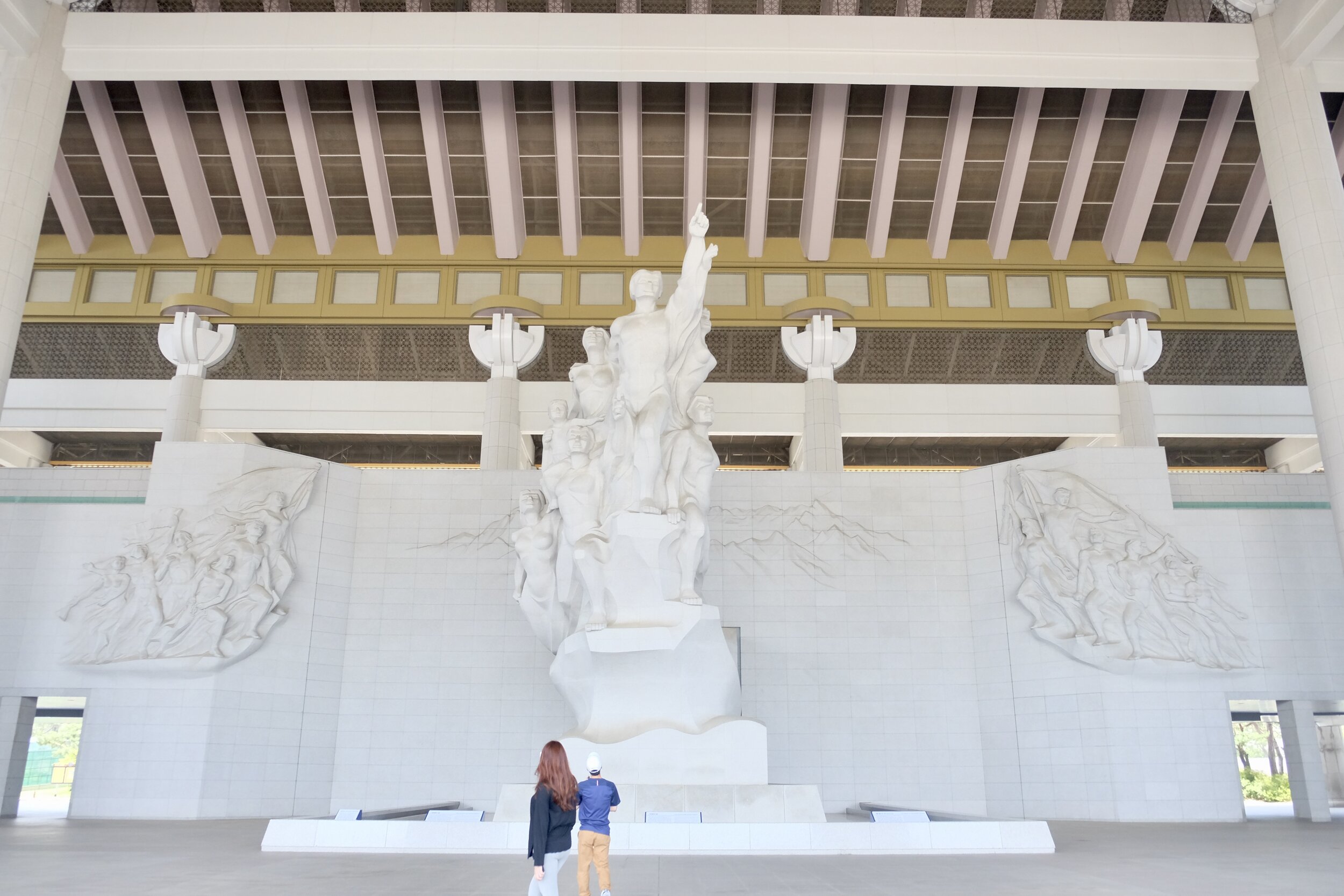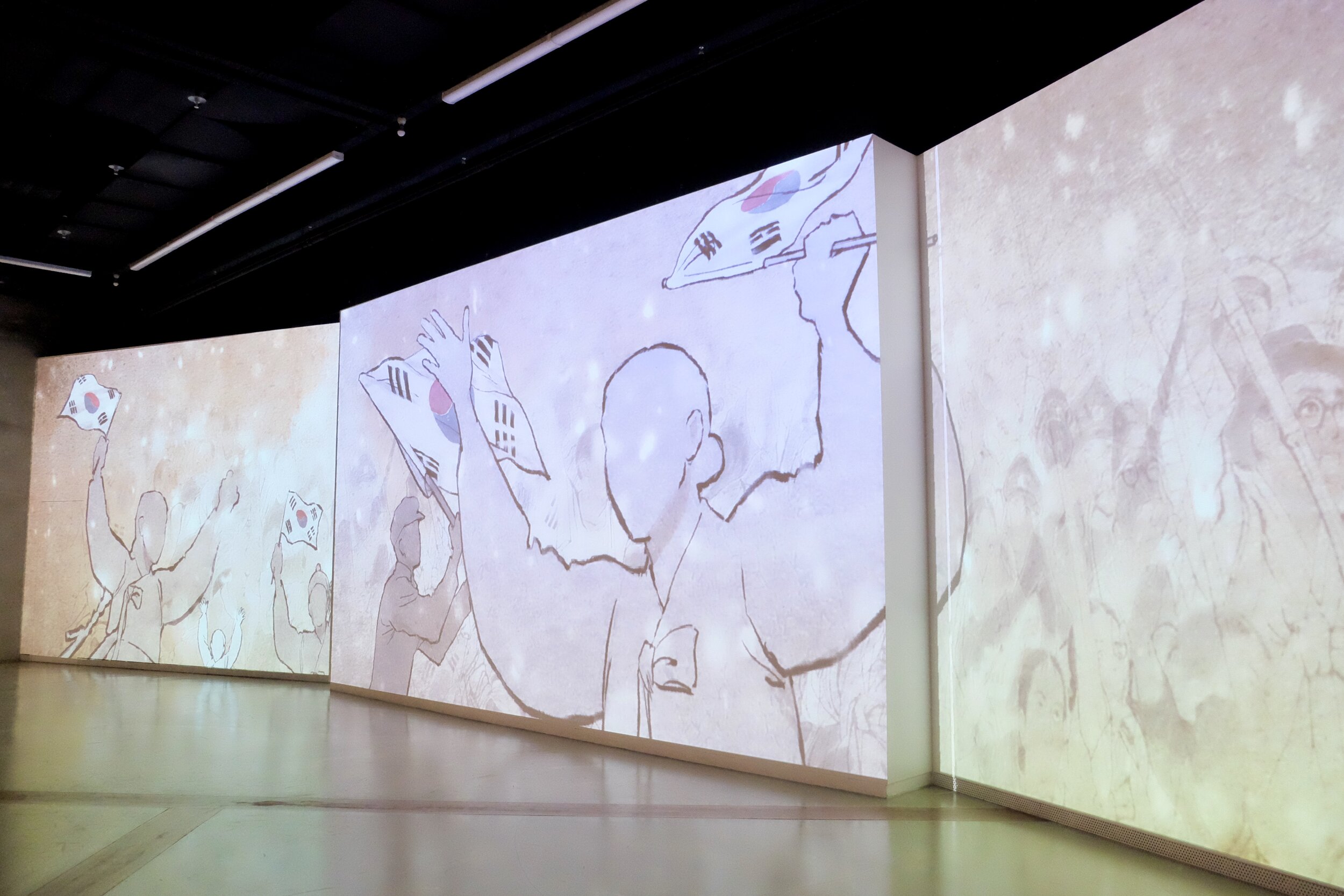So, we (well, one of us) had every intention of riding to Cheonan today. We even set up an alarm, woke up relatively early, and started to get ready. But then…
Neil: “Darling, I’ve had a thought, and think that your idea of taking the bus to Cheonan today instead of riding might be the better option.”
Jess: “REALLY? I mean, I understand.”
We had examined the route last night and noted that part of it went along the dreaded Highway 1. But we figured that we could just wing it and find a side path on the fly. Except looking closer now, we found that there weren’t really any. What roads there were would take us on a huge, hilly detour, which would really spoil our enjoyment of our last full day on the bike. And as we had had such a lovely ride the day before, we didn’t want to forever ruin the memory of the Four Rivers Bike Trail by trudging along pigheadedly just for the sake of reaching some meaningless milestone.
So we said to hell with it and took the bus.
With that decision made, a considerable load was taken off our minds, and we could take our time getting our stuff together. After some toast and jam on the house, we left the Khai Hotel and rode the 2 kilometres across the bridge to the city bus station. The next one going our way was in 15 minutes, which gave us enough time to deal with the usual faff of getting the tandem and our bags under the bus while the drivers stood shaking their heads in disbelief.
“There’s no way that’s all going to fit.”
“She’s going to get stuck for sure.”
“Oh, it worked.”
“Well, she’s very flexible. Do you think she’s Korean?”
The hour long journey was unremarkable, and we were in Cheonan in no time. The bus dropped us off next to a large shopping centre, we deftly removed the bike and our panniers, and stood there for a minute to catch our bearings and figure out our next move.
It was then that we realised, with a sense of horror and dread, that Neil had left our sandwich bag on the bus. The bag with our passports and other valuables in it. The bag without which we are pretty much screwed.
Jess immediately went into fight-or-flight mode, taking off towards the parked buses at a full sprint for possibly the first time in her life, praying that ours was still there, waiting for its next job. She started going on all the buses whose doors were opened, startling a sleeping driver in the one of them, and getting a cuss word or two thrown at her before word went around that a crazy “maybe Korean” woman was rampaging the place. One of the drivers came over to her and asked what was wrong, and in broken Konglish, Jess managed to convey that we were on the bus from Gongju that had just arrived 5 minutes ago, and holy hell were we in trouble if we lost that bag.
After much commotion, a very kind driver led her to the right bus where our previous driver was still standing. He was very confused when Jess ran onto the bus again (“I thought you got everything?”) but then started laughing when she raised the sandwich bag in triumph. “Next time, don’t bring so much stuff with you,” he chortled.
Slowly walking back to the place where she had left Neil behind, Jess felt her legs turn to jelly and her eyes stream with tears as the adrenaline faded away. After a good cry next to a sheepish Neil, she picked herself back together. All that’s well that ends well.
We rode across the main road onto Motel Row, and with minimal deliberation between the array of samey options, settled for the G7 Motel. At 40,000 won per night, it’s perfectly serviceable and gave us a room immediately, which meant we were able to drop off our bags and take only the essentials for our day trip to the Independence Hall Museum.
Cheonan has always been a major transportation hub of Korea, not only because of its proximity to Seoul, but also due to its location near a gap in the Charyeong Mountain Range which allows passage through to the major southeastern cities of Daegu and Busan. Due to its strategic location, Cheonan has also been an important postal hub, where early communications from the south converged before heading to Seoul, and messages from the capital diverged into the southern regions. More formal and structured mail services later emerged with the construction of the city's first postal outlets.
Now that it’s connected to the nation’s capital via subway and high-speed train, Cheonan’s population has boomed in recent years. The new KTX line has enabled commuters to work in Seoul while living in a cheaper, more manageable city. But despite (or perhaps because of) this, Cheonan itself has relatively little to hold the interest of the visitor.
But what it does have nearby is the incredible museum that we were about to see for ourselves.
Set in a wooded area east of town, Korea’s largest museum, the Independence Hall of Korea, is a concrete testament to the country’s continued struggle for independence during its most troubled time, from 1910 to 1945, when it suffered the indignity of being occupied by Japan. Originally home to the Korean government in exile in China, the building was disassembled and rebuilt in Korea after the nation was liberated from Japanese colonial rule on August 15, 1945. The Independence Hall officially opened on the anniversary of Independence Day in 1987 and now boasts seven exhibition halls, the Circle Vision Theater, and other facilities commemorating Korea’s struggle for freedom.
Each hall highlights different aspects of the occupation, with the most important displays labelled in English.
Historical and cultural artifacts from Korea’s 5,000-year history, primarily from the prehistoric age to the late Joseon Dynasty
Collections and historical pieces detailing the harsh realities of Japanese imperialism and the adversity of the nation in the late 19th century
Historical photographs of patriotic independence movements such as the Uibyeong (righteous army) Movement, Enlightenment Movement, and National Debt Repayment Movement
Historical records related to independence movements in the 1910s including the March 1st Independence Movement
Dioramas, models, and images related to the armed resistance and independence movements of the Independence Army (organised by the Korean Provisional Government) as well as other armies in Manchuria and elsewhere
Artifacts related to resistance movements against Japanese colonial rule such as the National Culture Protection Movement, various social movements, and the Korean Provisional Government
An experience hall and displays that use state-of-the-art technology to help visitors experience Korean history and the spirit of “Love the Country”
A striking symbol of the Independence Hall, Monument to the Nation, evoking an image of the wings of a bird soaring in the sky or the human hands in eager prayer, symbolises the indomitable Korean spirit throughout history and the strong resolve of the Korean people for independence, liberty, unification, and prosperity. The tower is 51.3 meters in height. Embossed on the 24 square meter platform is the map of Korea and 24 bronze signs signifying the 24 directions. The section of the “wings” is carved to resemble the Rose of Sharon, the national flower of Korea.
The Grand Hall of the Nation is the symbol of the Independence Hall and a venue for the annual national ceremony in commemoration of the Liberation Day (August 15). As large as a soccer field, 126m by 68m and 15 stories high, it is the largest tile-roofed house in Asia.
The halls are full of miniature and life-size scale models like these.
It’s like Lego on speed.
It would be worth dedicating an entire day to this museum if you can. We spent over 4 hours here, and it wasn’t enough to see everything before we had to catch the bus back to town. The wealth of knowledge on display, and dedication to preserving and sharing South Korea’s history, is astonishing. Though this was a relatively short period, the effects were devastating, with Korea suffering a full-scale assault on its national identity. Koreans were forced to use Japanese names and money, books written in hangul text were burnt, and the Japanese language was taught in schools.
During the occupation, Japan took over Korea’s labor and land. Nearly 100,000 Japanese families settled in Korea with land they had been given; they chopped down trees by the millions and planted non-native species, transforming a familiar landscape into something many Koreans didn’t recognise.
The most contentious issue remains the use of over 100,000 “comfort women”, who were forced into slave-like prostitution to sate the sexual desires of Japanese soldiers. The exhibition for this topic was particularly disturbing. It’s hard to do it justice in our own words, so instead check out this incredibly well-made animated short film, where you can hear the stories of Korean comfort women who were still alive at the time of production.
We were mentally exhausted by the time we got back to our hotel, so we relaxed for a bit before heading out again for dinner. After some Vietnamese food, we then found a lovely, mellow art gallery with a bar, where we lingered for the rest of the evening. Our reason for loitering might have had to do with the fact that we were seated next to the most awkward couple who spent an hour sitting in silence and staring into space. Break-up in progress or a first date gone wrong? We’ll never know.
One final stretch to Seoul in the morning!





















